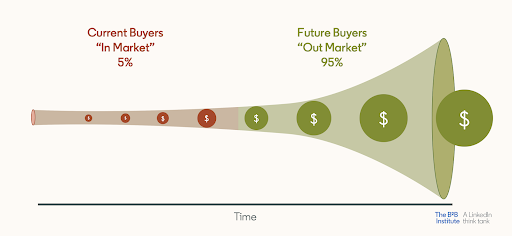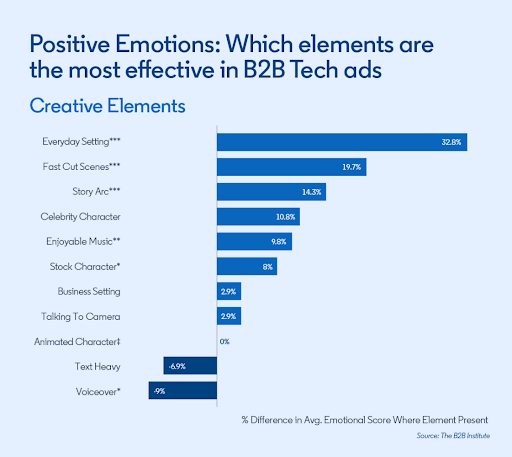The concept of jogging someone’s memory seems, on its surface, like an unscientific and inscrutable undertaking.
Memories and mental associations pop up at random. Right? The smell of a bakery reminds you of grandma’s cinnamon rolls. The color of a street sign invokes your old high school colors and jovial pep rallies. A friend’s choice of words causes you to blurt out a line from a classic comedy movie.
The thing is, these moments aren’t random. The memories are physically stored in your brain, and the scenarios and experiences that took place caused them to trigger in your consciousness.
Understanding this cause-and-effect relationship holds the key to effective B2B marketing that bridges brand with demand and leads to sustainable customer pipelines.
Marketing to future buyers
One of the most critical guiding principles of B2B marketing today – and one that’s been explored deeply by our clients at LinkedIn Marketing Solutions – is the 95-5 rule. In essence, it states that based on the nature of business purchasing cycles, 95% of customers in a given category at a given time are “out-market,” or not actively seeking your solution.
Obviously, that 5% of active “in-market” buyers is in high demand. There is fierce competition for their attention, engagement, and consideration. But if your marketing strategy is overwhelmingly focused on that very small subset of your audience, you’re leaving a ton of opportunity on the table – opportunity to gain a key advantage with those many future buyers.

(Source)
The purpose of today’s article, then, is to explore proven and data-backed ways to gain this advantage. How? By developing a brand content strategy focused on creating positive mental associations, so when your audience moves into a solution-seeking mindset, you’re the first that comes to mind.
4 Ways to Stay Top-of-Mind in B2B Buying Situations
1 — Create positive emotional response
In the 2016 Ipsos Connect report, “Emotion, Attention and Memory in Advertising,” Gailynn Nicks and Yannick Carriou explored the influence and scientific underpinnings of our subject at hand.
“The more consistent and appealing the emotional connections created and the more fitting the brand cues accompanying an emotion-based advertisement,” they wrote, “the more likely they are to be retrieved in the way that the advertiser desired at a suitable ‘relevant moment’. In behavioural psychology this is known as the ‘priming effect’.”
It’s easy to misinterpret what an “appealing” emotional connection is; taken the wrong way, that prompt could lead to a lot of sappy and fluffy content. To generate a positive emotional response, you don’t need to make someone laugh or feel happy (though you can). You just need to resonate.
The B2B Institute conducted an analysis of more than 600 B2B tech ads in the System1 database, and among their findings was this breakdown of creative elements that most strongly correlated with favorable emotional scores. I find the results interesting:

(Source)
While this analysis was specific to video ads in the tech industry, we can zoom out and think about the top elements through a broader B2B content marketing lens:
- Everyday Setting: In an increasingly hybrid and WFH world, audiences generally relate more to casual settings (and language) than formal business environments (and jargon).
- Fast Cut Scenes: Attention spans are short. Quick-hitting video cuts have the natural ability to catch the eye of a scrolling user. How else can your content create a sense of momentum?
- Story Arc: Stories are memorable, plain and simple. The structure and recognizable patterns naturally make information easier to recall. (Storytelling also builds trust.)
- Celebrity Character: The use of celebs plays off built-in recognition, trust, and affinity in your audience. Want a more accessible B2B use case? Think industry influencers.
2 — Associate your brand with its category
Of course, an ad or piece of content being memorable isn’t really valuable for a brand on its own – only if that memory is mentally tied to the brand, and to a potential future buying situation. That’s why the key to effective content lies at the intersection of impact and relevance.
“The key to effective content lies at the intersection of impact and relevance.” — Nick Nelson @NickNelsonMN Share on XFor an example of what I’m talking about, look no further than the Grand Prix Award-winning ad from the B2B Creative Lion category at Cannes 2022: “Speaking in Color,” from Sherwin Williams.
The content is personalized to its audience in a very broad sense, and seamlessly illustrates myriad use cases. Even while introducing and showcasing the company’s first-ever AI color system, the ad feels more like it’s trying to make an impression with a specific buyer audience, as opposed to selling them a product directly.
3 — Show up often and in the right places
Encoding your brand in the memory of your audience is partially a matter of standout creative, and partially a simple matter of frequency, repetition, and variety. The B2B Effectiveness Code – a joint report from WARC, Lions, and the B2B Institute – found that creative commitment is directly correlated with B2B campaign effectiveness.
What is creative commitment? It’s a calculation based on ad spend, campaign duration, and number of media channels. In other words, data shows that investing more robustly in creative brand campaigns pays off.

(Source)
4 — Measure the right things
If your campaigns are focused on building mental brand associations, then it is important to measure against that objective. Tracking sales conversions is a lagging indicator in a B2B world where sales cycles often span months if not years. Not to mention the challenges of attribution.
How can you gain a more real-time view of brand salience being driven by your content and ads?
Jon Lombardo of the B2B Institute recommends prioritizing these qualitative, feedback-based metrics as KPIs for creative ad campaigns:
- Ad recognition (“cut-through”). Do people remember seeing your ad? Did it rise above the noise and grab their attention?
- Ad recall. Do people who remember the ad attribute it to the right brand?
- Ad likeability. If people remember the ad and associate it with your brand, did they actually like what they saw?
- Ad clarity. Finally, if people saw the ad, attributed it to your brand, and liked it, did they easily understand the message you were trying to convey?
For more SEO-focused brand campaigns, you might choose a specific subset of keywords with strong intent relating to the campaign, and measure the growth of organic traffic and/or rate of conversions within them. Or you might use social monitoring tools to gauge sentiment shifts and increased awareness relating to your executive thought leadership campaign.
When possible, measuring share of voice can also be a valuable way to quantify the extent to which your brand is actually “top of mind” for your target audience.
ROI is obviously the ultimate name of the game, but waiting to get a clear picture of it can deprive B2B marketers of vital opportunities to understand and optimize how their content is performing in ways that substantially impact final results.
Make Your B2B Brand Memorable
This post is not by any means an argument against the value of lower-funnel, conversion-focused campaigns. Only a suggestion that those campaigns – and your customer pipeline as a whole – will be much more fruitful with an always-on branding strategy geared toward making your company and its content top-of-mind with relevant buyers … even if those buyers aren’t currently in the market.
Want to make some memories? Don’t forget to reach out to TopRank Marketing and learn about our best-in-class B2B content marketing services!



